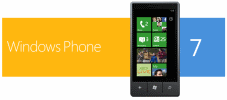Today, I attended Jaime Rodriguez (http://blogs.msdn.com/b/jaimer/) sessions on Windows Phone 7. Great sessions!!
Some of my notes:
- Main goals of Windows Phone 7:
- “End users” first (or at the center). Two aspects:
- METRO : Like in the subways stations, a pure and simple iconography can make a lot of sense to many people, i.e. they understand how to move around on the transports (not always easy to get started, but here in Berlin looking at the signs it was easy for mr to follow and get on the trains – I am french, and the principle worked).
- METRO is the Design language. It is content centric and use the same font.
- HUB : Integrated experience – a place to found links/content that are connected and group together to offer a better experience.
- METRO : Like in the subways stations, a pure and simple iconography can make a lot of sense to many people, i.e. they understand how to move around on the transports (not always easy to get started, but here in Berlin looking at the signs it was easy for mr to follow and get on the trains – I am french, and the principle worked).
- Great Platform
- Developers used to Silverlight or XNA development will be already familiar with some of the technolgogies used to build Windows Phone applications.
- Great Hardware
- The iPhone is/was great because Apple controls the hardware specification.
- Android, Google OS for Phones, does not control the hardware specs of phones manufacturers. As such, some mobile phones do not have the power to execute smoothly some of the applications and the end users experiences will not be good.
- Microsoft does not build phones. However, it has come up with a minimal hardware specification that all phone makers targetting the Windows Phone OS must fullfill. This also guaranties to the Windows Phone developers that their applications will run on a minimal set of hardware capacities (screen resolutions, CPU, RAM, …).
- “End users” first (or at the center). Two aspects:
Another main point I put down on my notes is the “tombstonning process”, i.e. the way that Windows Phone applications do not stay up and running in the background when an interruption comes (e.g. a phone call). In that case, your application is “Deactivated” and in most cases “tombstoned” (i.e. discarded from memory). This means that you need to serialized the application’s data and state during the “deactivated” event. Then, when your application is “(re-)activated”, you will need to read back that information and carry on like nothing happened for the end user.
To be honest, this is a new application life cycle that I do not like as a Developer. They might be good reasons to get this the way it is on Windows Phone (e.g. keep the minimum of processes running in memory in order to save energy, …), but it is not an easy concept to grasp and even less easy to develop with and test.
I hope this will be removed in a future version.
Have a look at Jaime’s powerpoint slides (http://blogs.msdn.com/b/jaimer/archive/2010/11/11/slides-and-demos-from-teched-sessions.aspx).


1 Comment